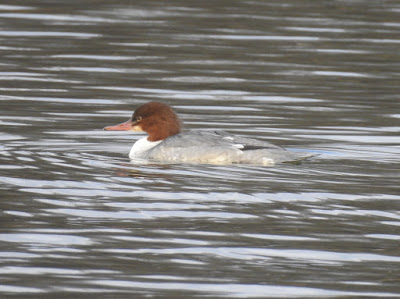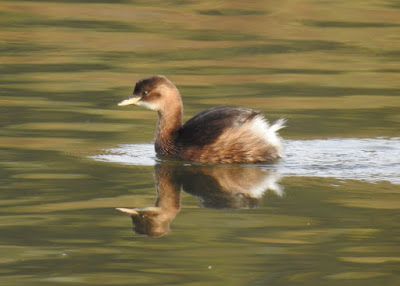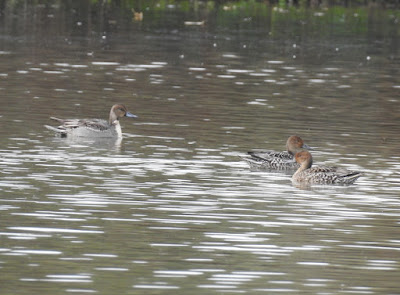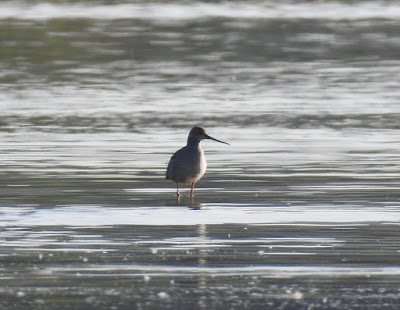This is the 5th year that I have been seriously year listing my patch, though I did have a go in 2012 as well. Annual totals have been remarkably consistent given that the overall make-up differs from year to year:
2012: 130
2013: 136
2014: 136 (plus Siberian Chiffchaff)
2015: 135 (plus Siberian Chiffchaff)
2016: 133 (plus Siberian Chiffchaff)
This year has been going along very nicely and you can see from the totals on the right that the Spotted Redshank on Sept 1st put me on 133 for the year with 4 months still to go and several 'easy' species still to see. So I was very hopeful of beating my previous best and hopefully breaking through the 140 barrier.
Well I didn't have to wait too long for the next new species. Simon R texted me on Sept 10th saying that he had found a couple of
Ruff. I was soon down there and enjoying two juvenile birds, a male and female showing a distinct difference in their sizes. Ruff is just about annual, so it is easy to miss them during any year and a nice one to get.
The same day saw my last
Swift of the year pass overhead.
On Sept 11th, I came across only my second patch
Marsh Tit. Both records have been in September and presumably relate to dispersing birds. This one was feeding in a hedge at Pump Lane and gave itself away by being quite vocal, though it spent all the time I watched it on its own, happily feeding away.
This put me on 135 for the year and just a single species to match my best ever.
Early September had seen quite a few
Yellow Wagtails passing through, often seen feeding around the cattle in Spade Oak meadow. However, I was pleased to see my largest flock yet on Sept 13th when at least 45 birds were around the cattle. They were not easy to see on the ground as the grass was too long, but they were quite flighty and at one point all took to the air.
Passage
Yellow-legged Gulls have been well down this year on previous years and doesn't bode well for future sightings of LWHG as I suspect that it is related to the running down of Hedgerley landfill. Hopefully I will be proved wrong! There has been a very regular adult, but on the 16th, I had a juvenile, which sadly was my first this year. Typically, at this time of year, it had moulted all of its scapulars and a fair few coverts as well.
On Sept 18th, I had my largest flock of
Ravens on patch when a party of five birds, possibly a family group, spent some time soaring over the north side of the lake with Red Kites and Buzzards.
Having seen my first returning
Great Black-backed Gull on the 11th, an adult bird, it was nice to see a juvenile on the 18th. I can't remember seeing birds in this plumage here before, though obviously 1st winters are regular enough in the winter.
I was getting very worried about both Whinchat and Spotted Flycatcher. Both are regular enough, particularly Whinchat, but I had seen neither species so far this year and time was ticking. However, on Sept 19th, I was extremely pleased (and relieved) to find a
1st winter Spotted Flycatcher feeding away in a small clump of bushes at the top of Emmett's fields. This would prove to be my only record of the year! The same day saw my last migrant
Sedge Warbler of the year.
This bird put me on 136 species for the year, equalling my best ever and it was still only mid September!
On Sept 24th, Jim R texted to say he had three smallish terns on the east side of the lake. As I was nearby, I was quickly on site on the east side and found three
Common Terns, but on looking, there were actually five birds dipping about the lake. They hadn't been there earlier in the day so had arrived mid morning. Whilst watching the terns, a
Yellow Wagtail flew over calling and will probably be my last of the year.
The forecast for the 25th was damp with easterly winds, so I was hopeful that there would be something good on site. I was not disappointed to find two moulting adult
Black Terns together with an adult Common Tern.
Another hunt around the patch for the ever dwindling chance of Whinchat almost paid off when I discovered a distant chat on the fence line next to the athletics track, which is a favoured spot for this species. However, it turned out to be a
male Stonechat - still new for year, but not the chat I was hoping for at this stage.
The 26th was fairly uneventful, though I did see my first
Water Rail of the Autumn. However, there was an intriguing situation - as I stood in the big swim on the south side of the south-east corner, I thought a heard a Yellow-browed Warbler call from the other side of the corner - a distance of about 80 yards or so. I only heard it once and went straight over to the area it came from. I stood around there for some time but saw and heard nothing further so wrote it off. However, on the 27th, I was passing the same spot (between fishing pegs 28 and 27 just north of the south-east corner) when for some reason, I decided to look into the gloom of a bush where a Chiffchaff had just chased another presumed Chiffchaff only to find that the chased bird was in fact a
Yellow-browed Warbler!!!! I saw its long yellow supercilium and two wing bars clearly before it disappeared into the pretty dense vegetation in that area. I quickly sent out messages to the locals and county grapevine just as the bird called a couple of times - surely this bird had been here the previous day!
The first man on site was Dave P, but this bird was extremely uncooperative. It only called occasionally and spent long periods of time not calling at all, plus the area it had chosen was very difficult to view, quite thick and dense. As we watched the bush in which I had first seen the bird, I thought I had it again, as a small green bird with an obvious supercilium half hidden by leaves made its way towards us. "Here it is" I said, just as the bird materialised as a
Firecrest! Unbelievable! Only my second on patch, despite them breeding only a few miles away - this had turned into a classic morning.
By now, a few more of the regulars were on site. We were treated to a prolonged period of Yellow-browed Warbler calling, but could still not see it. After a while, I decided to play its call briefly to see if it would respond. It did (and this was the only time that it did when I tried, so this was kept to a minimum) and appeared in open branches just above our heads giving everyone a good view. It didn't last long however and it was off again.
Remarkably, the bird stayed fairly faithful to a small area of vegetation in the same general vicinity for the next five days and departed overnight on Oct 2nd. A great bird to have on patch and eventually seen by all who wanted to visit. Photos were never easy and I failed to get any, but Mick V who came over on the 2nd managed a couple of corkers, linked
here. Needless to say this was a site first and only about the 9th county record.
Probably my last
Willow Warbler of the year was seen on Sept 29th moving through the same area of vegetation as the YBW.
Back to birding normality after the excitement of the YBW and I notched up my 140th species of the year this morning - a number I was hoping for and seemed more and more likely as the year went on. I hadn't seen much on arrival, six Snipe down from nine yesterday, 15 Wigeon, still quite low in number and no calling Cetti's this morning - there had been one singing near the west bench yesterday and a second male is often singing on the north-east side. I made my way to the south bank. A small passage of Skylarks and Meadow Pipits kept me busy, going over in 2s and 3s. At 9:15am I noticed a wader flying over the spit being chased by about 10 Jackdaws. Through bins I could see it was a
Ruff. It banked over the trees and came back round over the spit. As I watched it, I noticed a distant line of birds flying west over Emmett's fields. I was hopeful that these were
Golden Plover, a species I had not seen earlier in the year, so I quickly used my scope and indeed they were Goldies, about 20 of them, they continued west then north-west. These had distracted me from the Ruff, which had obviously not taken to being chased around and had not landed, but nice to get a second record this year.
So with 140 reached, how much further can it go? There are still some reasonable chances of further species: Whinchat has probably bitten the dust (unbelievably!), though there is still time - my latest local record is Oct 14th; Pintail and Goldeneye should make an appearance and Goosander is possible; Jack Snipe might well turn up and then there are the scarcer birds such as wild swans, owls and maybe another Hen Harrier, who knows? But I will enjoy searching.




















































